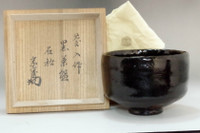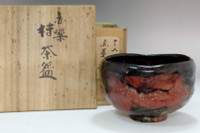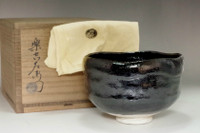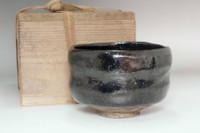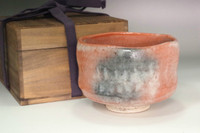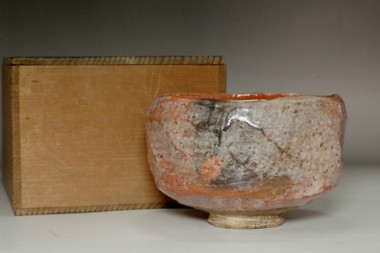 Loading... Please wait...
Loading... Please wait...Currency Displayed in
- Home
- SOLD ITEMS
- 11th Raku Keinyu (1817-1902) Aka-raku tea bowl #4194
Categories
11th Raku Keinyu (1817-1902) Aka-raku tea bowl #4194 for sale
Product Description
Up for sale is this "11th Raku Keinyu (1817-1902) Aka-raku tea bowl #4194" If you have any questions please contact us before buy it. No reserve.
- width: approx. 12.3cm (4 27⁄32in)
- height: approx. 8cm (3 5⁄32in)
- weight: 294g (gross 498g)
- condition: small damaged on the rim
The Eleventh Raku - Keinyu (1817-1902)
Born as the third son of Naohachi Ogawa, a sake brewer from Tamba Province, in what is present-day Kokubu, Chitose-cho in Kameoka City, Kyoto Prefecture. He first went by the name Sokichi, and he was later renamed Yoshitsura. At the age of 11, he was adopted by Tannyu X, later taking Tannyu's daughter Myokoku as his wife. At the age of 29, he succeeded Tannyu as patriarch of the family, taking the name Kichizaemon. At the age of 55 he went into retirement, and passed away at 86. His period as an active ceramicist was second only to Ryonyu IX. He was also interested in poetry, calligraphy and, above all, was a passionate devotee of tea ceremony. Rokurokusai, the 11th headmaster of the Omotesenke school, bestowed upon him the highest title of "kaiden." Keinyu lived in an era of change as the Edo Period gave way to the Meiji Era, when the Shogunate restored imperial rule. This was a painful time, where traditional culture such as tea ceremony went into decline, buffeted by the Europeanization policies of the new regime during the so-called Rokumeikan era. Even the head of the school was forced to rely on the support of a wealthy regional patron. Rokurokusai himself spent a significant period of time with wealthy patrons, first in Hagi then in Bizen, etc., where he spread tea ceremony into the regions. Keinyu joined Rokurokusai in Hagi, and during their time staying there the former assisted the latter. Keinyu also created works at Hagi-ware kilns. His works from this era include Hagi bowls, incense containers and pitchers. At the age of 38, a blaze that began in the Kyoto Palace destroyed all but one of the Raku-ware storehouses. Nevertheless, Keinyu dealt with these many misfortunes with great fortitude. He went on to create a wide array of works, ranging from bowls to plates and pots, as well as utensils for kaiseki, tea-ceremony dishes, and tea ceremony. This cemented him as one of the great masters alongside Donyu and Ryonyu. An admirer of the creativity of these two masters, Keinyu's style is one of consummate balance and exquisite decorations created with spatulas. On the whole, many of Keinyu's bowls are delicate and compact, some of which are amongst the smallest works of all generations. This is no doubt a reflection of the era, which was far removed from the opulent heyday of tea ceremony. However, this is also an expression of Keinyu's personal approach to the spirit of tea ceremony, which he diligently performed in his own home. At times he tended toward sweeping grandeur, with a powerful style; at other times his style shifted toward a refined, restrained elegance. Throughout his life, he regularly changed his seal, and his works can be loosely divided between these periods. From when he took over the Raku school at the age of 29 until he faced the great fire at age 38, he used a spiderweb seal (initial seal) which was penned by Daiko Soken of Daitoku Temple. Subsequently, from the age of 38 until he retired at 55, he used a seal called Dong Qichang (middle seal). Keinyu was well versed in calligraphy and was a great admirer of the works of Dong Qichang. From the age of 55 until his death at 86, he used the Shiroraku seal (retirement seal). Other seals he used include "Tenka-ichi," a seal commemorating the 250th anniversary of the passing of Jokei, a seal from Nishi-honganji Temple's Rozan-ware called "Untei," and a Raku seal in cursive font (Kishu official seal). His representative works include black Raku bowls named "Irifune" and "Taiku," a Shiroraku bowl named "Shiohi" and a large goose-shaped incense bowl.
shop policy
AppraisalWe are a very small team with limited resources and are unable to conduct scientific age verification or appraisals by the artist’s descendants. We evaluate items using specialized reference books, scholarly resources, and knowledge inherited from senior experts in the field. If a purchased item does not meet your expectations, please feel free to contact us. We sincerely value your opinion.
Cancellation and Return
We accept return only if you contact us within 30 days after you receive the items. Return-shipping costs are the buyer’s responsibility. If you ask a cancellation before shipping the package, we may ask a 20% restocking fee.
Shipping
+ Shipping to the USA, Europe, and Asia is free. For other areas, please contact us. Shipping is via EMS or DHL.
+ VAT is not included in the item price.
+ We will ship within 3 business days. Shipping time is usually around a week.
Insurance
We are not responsible for delays, returns, damage or loss due to customs or postal processing. EMS is insured (the amount on the label is the guaranteed amount). If you choose DHL, we recommend that you purchase additional insurance. Please note that if you choose the DHL drop service option, insurance will not be applied.
Taxes
Import duties, taxes and fees are not included in the item price. If your country requires customs duties, etc., it is your responsibility to pay them.
To customers buying tableware
Our products are mostly used. We sell them in the same condition they were purchased, please be sure to clean them thoroughly before actually using them.

